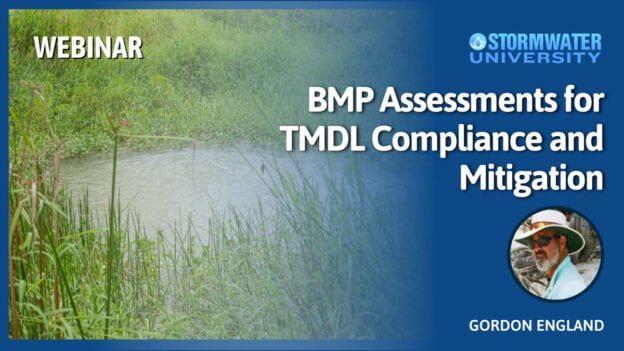Discover effective strategies for implementing stormwater pollution reduction programs while adhering to Total Maximum Daily Load (TMDL) regulations. In this course, Stormwater University speaker, Gordon England, will delve into a methodology developed in Florida that enables communities to assess and categorize BMP costs and performance accurately.
Drawing upon data from four proposed BMP types, this course explores the standardized nutrient pollutant loading calculations, BMP performance criteria, and uniform BMP costing methods used in evaluating 115 proposed projects on a barrier island. Through this rigorous analysis, we achieve an unprecedented level of accuracy in our multivariate examination. A regression analysis indicated metrics of annual costs per pound of TN and TP removed per acre treated provided a comparison of nutrient removal cost effectiveness of Wet Detention Ponds, Dry Detention Ponds, Exfiltration Trenches, and Floating Vegetated Islands. In addition, calculations provided composite TMDL mitigation costing factors.
Learning Objectives
Upon completion of this course, attendees should be able to:
- Demonstrate removal efficiency calculations for various BMPs
- Use regression analysis to determine BMP valuation metrics and TMDL credit costs for Nutrient Mitigation Banking
- Utilize proper metrics during multivariate analysis to compare BMP performance
About the Presenter

Mr. England’s career spans 42 years of public and private sector Civil Engineering work, giving him unique skills in the design, policy making, and compliance aspects of stormwater quality measures to reduce pollution in stormwater runoff. He pioneered the use of many types of BMPs.
With Stormwater Solutions, Mr. England developed Stormwater Quality Masterplans for Cape Canaveral Air Force Station, Patrick Air Force Base, Indian Harbour Beach, Satellite Beach, Stuart, Pensacola, and Kissimmee. In those masterplans, watersheds were modeled for nutrients using GIS based spreadsheets. These studies were key tools for entities to utilize in addressing TMDL mandates for impaired waters.
A Stormwater Masterplan was also developed for Nassau, Bahamas to address numerous flooding problems on the island. Design and permitting standards were created for the government to use for controlling drainage associated with new development. A maintenance program and manual were developed to organize government personnel and maintenance activities.
Mr. England served as Senior Engineer with the Brevard County Stormwater Utility department for numerous municipal stormwater projects in Brevard County. His experience includes project selection, consultant selection, project design, design review, and writing permitting ordinances and Comprehensive Plan Stormwater Elements for Brevard County. He recently assisted Brevard County with GIS mapping of existing infrastructure, investigation of potential projects for TMDL compliance, and resilience planning for sea level rise and flood control.
Mr. England gave a peer review for development of BMP certification procedures for the Auckland Council of New Zealand.
In the private sector he wrote successful stormwater grant applications totaling over $50,000,000 in construction projects for 26 cities and counties.
He is a prolific author who has written six books about outdoor and Caribbean adventures, plays, songs, poems, and over 75 short stories.




